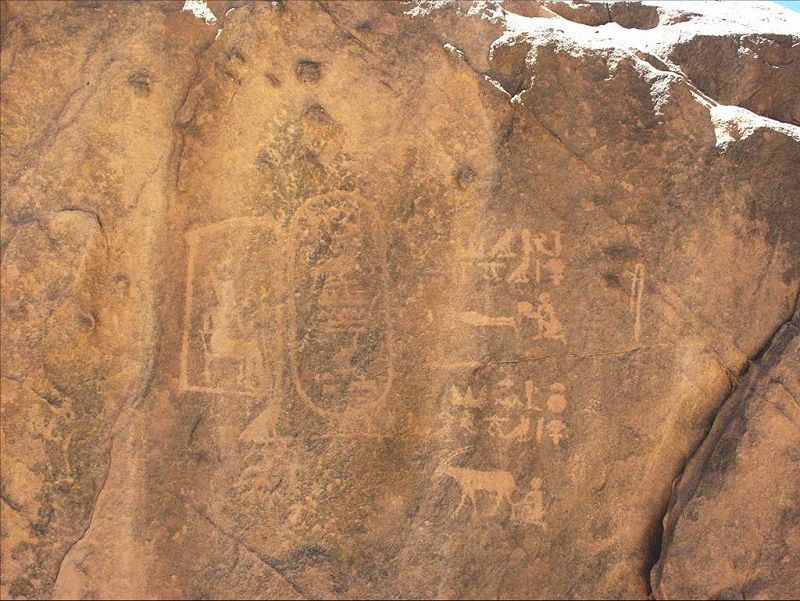Exodus From Drying Sahara Gave Rise to Pharaohs, Study Says
Sean Markey
for
National Geographic News
July 20, 2006
The pharaohs of ancient Egypt owed their existence to prehistoric climate change in the eastern Sahara, according to an exhaustive study of archaeological data that bolsters this theory.
Starting at about 8500 B.C., researchers say, broad swaths of what are now Egypt, Chad, Libya, and Sudan experienced a "sudden onset of humid conditions." (See a
map of Africa.)
For centuries the region supported savannahs full of wildlife, lush acacia forests, and areas so swampy they were uninhabitable.
During this time the prehistoric peoples of the eastern Sahara followed the rains to keep pace with the most hospitable ecosystems.
But around 5300 B.C. this climate-driven environmental abundance started to decline, and most humans began leaving the increasingly arid region.
"Around 5,500 to 6,000 years ago the Egyptian Sahara became so dry that nobody could survive there," said Stefan Kröpelin, a geoarchaeologist at the University of Cologne in Germany and study co-author.
Without rain, rivers, or the ephemeral desert streams known as waddis, vegetation became sparse, and people had to leave the desert or die, Kröpelin says.
Members of this skilled human population settled near the Nile River, giving rise to the first pharaonic cultures in Egypt (related feature:
sample and download Egyptian music).
Gift of Pottery
The new study, which appears online today on the
Science Express Web site, is based on painstaking research that combines new radiocarbon dating of about 500 artifacts from the region with data from past studies.
Kröpelin and study co-author Rudolph Kuper also collected geological climate data from countless ancient lakebeds, rain pools, and rivers.
Over the course of 30 years the researchers labored for months at a time in deserts where daytime temperatures sometimes topped 120° to 140°F (50° to 60°C).
The information collected allowed the scientists to piece together a picture of the ancient climate, environment, and migration of prehistoric peoples in the eastern Sahara over the past 12,000 years.
Among their findings, the researchers provide further evidence that the human exodus from the desert about 5,000 years ago is what laid the foundation for the first pharaohs' rule.
"Egypt is a gift of the Nile, as Herodotus said, as many people still think today," Kröpelin said, referring to the 5th-century B.C. Greek historian. "But at the same time also it is a gift of the desert."
"Without the tradition and the know-how and the knowledge of the desert, probably the Egyptian pharaonic civilization wouldn't have emerged as it did."
For example, pottery was first invented in Africa in the Egyptian Sahara at the same time, if not before, it was developed in the Middle East.
"[Pottery] is the first modern plastic, one of the most important inventions in human history," Kröpelin said.
The innovation provided the economic basis for the Neolithic revolution—a period of human cultural development about 5,200 to 4,500 years ago.
Pottery vessels enabled nomadic peoples to preserve and store food and thus settle down (photo:
excavating ancient Egyptian pottery).
"It was really a very, very big step in human evolution, and this happened in the desert," Kröpelin said. "Only when the desert dried out, this condition was brought to the Nile Valley."
Adding Some Meat
In their study, Kröpelin and Kuper also describe how pastoral cultures moved along with the desert's southern march.
The ancient peoples' progress helped sow aspects of farming, particularly domestic animal herding, throughout Africa (explore an interactive atlas of the
human journey out of Africa).
David Phillipson, a professor of African archaeology, directs the Museum of Archaeology and Anthropology at the University of Cambridge in England.
The study "adds a great deal of meat and detail to something which has been envisaged for a little while," he said.
"And it's extremely useful to have this, because it enormously increases the amount of basic data on which the conclusions are drawn.
"As the Sahara dried and became less suited and eventually unsuited to habitation, people ultimately had to move out, whether it be southward or to the east into the Nile Valley," Phillipson said.
"And this [study] helps [us] to understand the apparent rather sudden development of intensive settlement by sophisticated societies in the Nile Valley 'round about five or six thousand years ago
Exodus From Drying Sahara Gave Rise to Pharaohs, Study Says

